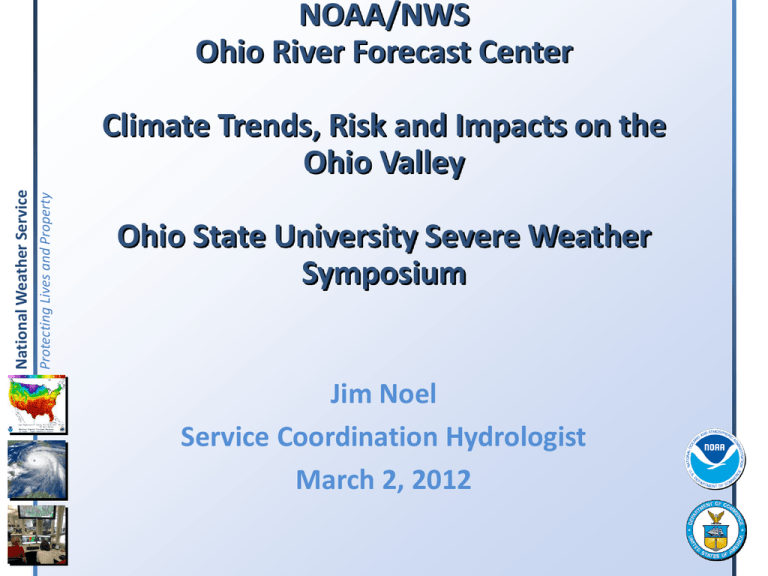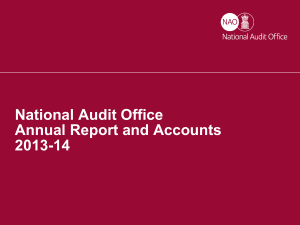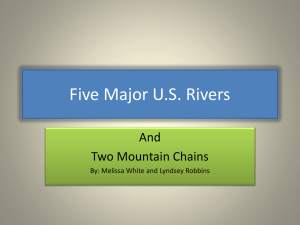Climate Trends, Risk and Impacts to the Ohio Valley
advertisement

NOAA/NWS Ohio River Forecast Center Protecting Lives and Property National Weather Service Climate Trends, Risk and Impacts on the Ohio Valley Ohio State University Severe Weather Symposium Jim Noel Service Coordination Hydrologist March 2, 2012 Today’s Discussion Protecting Lives and Property National Weather Service Climate Trends – Annually and Seasonally Risk from Cyclone Frequency ENSO, NAO Climate Impacts on Ohio 2012 Seasonal Outlook Questions/Comments Temperature/Rainfall Annual Trends Protecting Lives and Property National Weather Service Trend in Ohio has been for warming from 1976 to recently Trend in Rainfall has been for increased rainfall from 1976 to recently Much of the increase has been in late summer through autumn Temperature/Rainfall Winter Trends Protecting Lives and Property National Weather Service Most significant warming has occurred in the winter season Only minor increases in winter precipitation Protecting Lives and Property National Weather Service Temperature/Rainfall Spring Trends Some warming in spring in Ohio Only slight increase in peak flood season rains Protecting Lives and Property National Weather Service Temperature/Rainfall Summer Trends Little change in overall summer temperatures Some increase in summer rainfall Temperature/Rainfall Autumn Trends Protecting Lives and Property National Weather Service No change in autumn temperatures Most significant increase have come in fall low flow season and harvest season Temperature/Rainfall Autumn Trends Protecting Lives and Property National Weather Service Ohio fits composite of United States generally Greatest warming in cool season Greatest increase in rainfall in autumn Protecting Lives and Property National Weather Service Climate Trends in Hydrology • Most trends are up especially from Deep South to Ohio Valley and Northeast. USGS Median Daily Flows • For Ohio, streamflows trends are up in 2-3 of the 4 seasons for minimum and median flows, especially autumn and late summer • Little change to all seasons in Ohio for maximum flows USGS Maximum Daily Flows Credit: USGS Protecting Lives and Property National Weather Service Cyclone Frequency Trends and Risk Natural variability in the system does account for some of the change, climate system is always changing, but we can’t explain all the change through natural processes 1900 to 1950s was very active then less active period from 1960s to 1990s We have now returned to a more active period with INCREASED RISK! Protecting Lives and Property National Weather Service Climate Impacts on Ohio – La Nina Risk • La Nina is the cooling of the eastern Pacific Ocean waters near the equator • Thunderstorms in the western Pacific Ocean create downstream impacts into North America • Commonly wet in Ohio Valley Protecting Lives and Property National Weather Service Climate Impacts on Ohio – La Nina Risk • Typically La Nina events have their best relationship during the winter and early spring • The stronger the La Nina the better the relationship • Heavy rain along the Ohio River and adjacent areas is common Protecting Lives and Property National Weather Service Climate Impacts on Ohio – El Nino Risk • Typically El Nino events have their best relationship during the winter and early spring • The stronger the El Nino the better the relationship • It tends to be drier in Ohio Protecting Lives and Property National Weather Service Climate Impacts on Ohio – NAO Risk • North Atlantic Oscillation – relationship between low pressure near Greenland and high pressure in the Atlantic Credit: Columbia University • Positive phase tends to be warm and wet winters • Negative phase is colder, not as wet but snowier • NAO has been more negative since early 2000s • Typically late winter and spring are wet with a positive NAO Protecting Lives and Property National Weather Service Climate Impacts on Ohio – NAO Risk • Typically late winter and spring are drier with a negative NAO • Hard to predict NAO past 2-4 weeks but climate models are getting better 2011 Rainfall – La Nina, NAO Risk Protecting Lives and Property National Weather Service La Nina • There was a significant La Nina in early 2011 • The risk was > 1.5 times the normal for extreme rainfall events in the big La Nina events North Atlantic Oscillation • North Atlantic Oscillation switched from negative (colder/dry) phase in winter to positive (warmer/wet phase in spring • Many other reasons too as climate/weather is quite complex Current NAO Protecting Lives and Property National Weather Service • Strong Negative NAO fall and early winter 2010/2011 • Strong Positive NAO fall and early winter 2011/2012 • Generally staying neutral to positive for rest of January supporting • If NAO stays positive it supports warmer weather through spring then near normal for summer still warmer in western corn belt Protecting Lives and Property National Weather Service Climate Impacts on Ohio - Example • NAO a Factor • Positive NAO at least a contributing factor in warm weather in the East. Protecting Lives and Property National Weather Service Ohio Corn Production Historical Yield Data, 1930-2007 Climate Impacts on Ohio - Example 1951 1953 5 0 -5 -10 -15 -20 -25 -30 -35 -40 1955 1956 1958 1961 1962 1969 2005 2001 1988 1975 1971 1970 1969 1962 1961 1958 1956 1955 1951 1971 1975 1988 2001 Year 2005 NAO/1 1967 1976 20 10 0 -10 -20 -30 -40 -50 -60 1980 1982 1986 • When NAO is positive, corn yields up 8% above normal in Ohio • NAO does change over time and is influenced by many factors 1987 1989 1990 Year 2004 2002 1994 1993 1992 1990 1989 1987 1986 1982 1980 1976 1992 1967 Yield • When NAO is negative, corn yields 10% below normal in Ohio 1970 1953 Yield Protecting Lives and Property National Weather Service NAO/-0.5 1993 1994 2002 2004 Research: Joint Ohio State University and NOAA/NWS/Ohio River Forecast Center Climate Impacts on Ohio - Example Protecting Lives and Property 20 1950 10 1954 1955 0 1956 1964 -10 1970 1971 -20 1973 1974 -30 1975 1985 1988 -40 • Crop yields fall typically 10-12% below normal when a La Nina or El Nino event occurs in the Pacific Ocean. 1999 1988 1985 1975 1974 1973 1971 1970 1964 1956 1955 1954 1950 1999 Year El Nino - Corn Year 2002 1997 1994 1993 1992 1991 1987 1983 1982 1972 1969 1965 1958 20 10 0 -10 -20 -30 -40 -50 -60 1957 Yield National Weather Service Yield La Nina - Corn 1957 1958 1965 1969 1972 1982 1983 1987 1991 1992 1993 1994 1997 2002 • More fluctuations in our climate will yield greater fluctuations in ENSO which will have an impact on Ohio agriculture Research: Joint Ohio State University and NOAA/NWS/Ohio River Forecast Center Protecting Lives and Property National Weather Service U.S. Climate Forecasting System Temperatures Warm winter linger into spring with temperatures trending to normal by later spring and summer Protecting Lives and Property National Weather Service U.S. Climate Forecasting System Rainfall Wet winter lingers into part of spring then turning drier than normal by June and summer Japan Climate Forecasting System Protecting Lives and Property National Weather Service Winter Spring Summer Goal from climate models is can we gather an Positive NAO Protecting Lives and Property National Weather Service NAO PDO Winter La Nina Spring Summer NAO forecast to remain positive, La Nina to end, PDO to remain negative. Look for trends and need to know biases Protecting Lives and Property National Weather Service Water Resources Outlooks http://www.erh.noaa.gov/ohrfc/WRO.shtml Water Resources Outlooks Protecting Lives and Property National Weather Service Subscribe to the Ohio River Forecast Center Water Resources Outlook Monthly Outlook talking about flood and drought risk and rainfall and temperature risks Probability maps Website: http://www.erh.noaa.gov/ohrfc/WRO.shtml Subscribe: https://public.govdelivery.com/accounts/USNWS/su bscriber/new?topic_id=USNWS_1048 Discussion: http://www.erh.noaa.gov/ohrfc/HAS/text/wro.txt Summary Protecting Lives and Property National Weather Service Climate System is complex (no silver bullet) ENSO and NAO impact our weather, more so when events are strong Many other climate regimes impact the weather as well 2012 will be different than 2011,likely fewer extreme events It is all about risk management! What is the risk of events occurring! The risk appears to shift from active to inactive from spring into summer. Summary Protecting Lives and Property National Weather Service Even though risk for extreme events may be less overall in 2012 than 2011, “RISK” will be elevated for at least the next 1020 years overall. Questions! Protecting Lives and Property National Weather Service James.Noel@noaa.gov NOAA/NWS/Ohio River Forecast Center Service Coordination Hydrologist THANKS!





